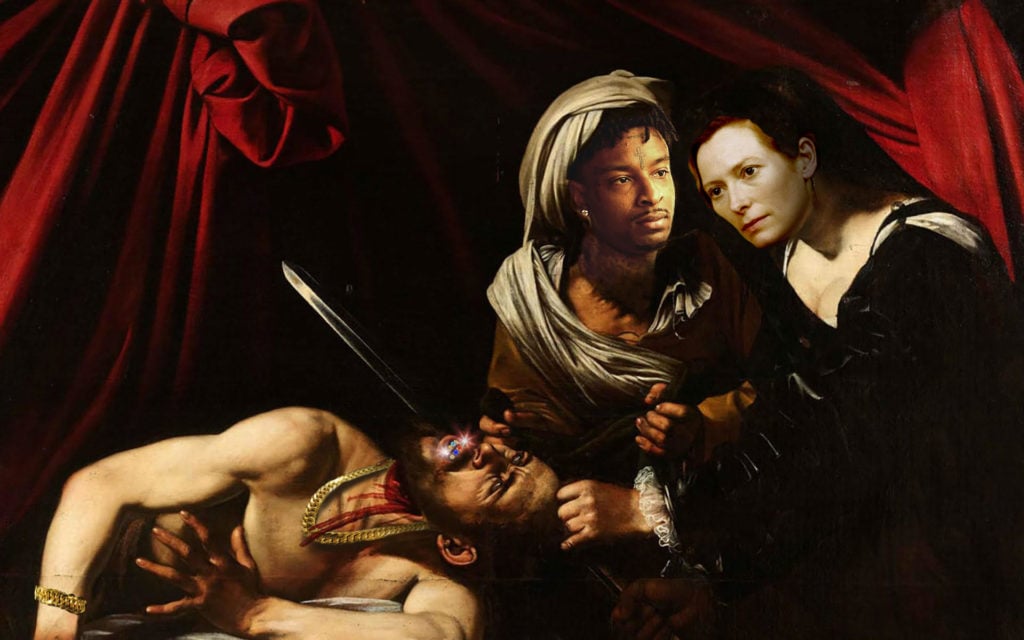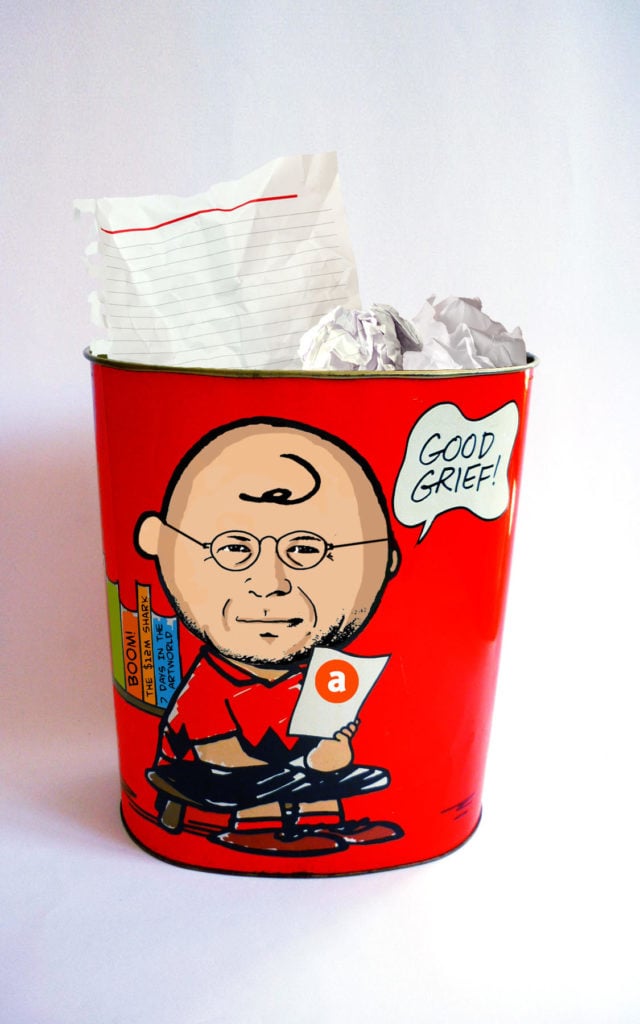For the first 24 hours after I post on artnet News, I shut down all communication devices—”paranoiac” or “delusional” are not the words after I’ve suffered physical intimidation, verbal abuse, and, worse, legal threats from the fallout of columns past. But to date, for better or worse, I’ve managed to remain unscathed. I’ve been close to quitting, throwing in the towel, as I do this all but for free (artnet, time for a raise?) and the upside is difficult to gauge.
That was then, but now there’s been another slate of auctions for me to cover. Sorry—I couldn’t help myself from weighing in before the art world goes on summer break. But don’t worry, just like the recent London auctions, this roundup will be short and sweet(ish).
When I first moved to the UK in 2004 there was talk of London superseding New York as the world’s auction capital, the momentum was thick in the air, and the city was bursting (and bustling) with opportunity and optimism. Yet the fall of the city’s art scene over the 15 years since has been nothing short of precipitous, I got out just in time. London’s violent petty street crime alone is hair-raising enough, and that’s before you get to the political turmoil, which would be laughable if it weren’t so sad, and entirely self-wrought.
The reasons why you’d choose to sell in London (consider it auction lite) are manifold, from the obvious death, divorce, and debt—the art market is teeming with it, more than ever—to the appeal of trying to be a big fish in a little pond (or puddle, more like), garnering more attention on your artworks. Sometimes, such a strategy succeeds, as was the case with the work of several white-hot young black artists; more often than not, not. Before I dip into the (exceedingly) shallow waters of the contemporary sales, there are a few general matters at hand to discuss.
First, I found a solution for the mid-sized gallery crunch, though you may not be too amused: close them all! There should only be three galleries remaining, a high-stakes battle between behemoths with Larry G. vs. David Z. vs. Ivan the Terrible (I’m playing). Case in point? Aspiring market darling Avery Singer, Wikipedia-described as “an American artist (born 1987) known for paintings created through 3D modeling software and computer-controlled airbrushing.” Where can I get a robotic paintbrush? Avery’s meteoric auction prices went from $36,000 in 2017 to $735,000 a year later, for a painting bought by Gagosian, no less. (He may want to check the condition on that one.)

Columnist Beware! Me after my next artnet column if I’m not careful…. Photo illustration courtesy of Kenny Schachter.
And now, as the three little pigs—just kidding… they are far from little, and I love and respect them all—jostle to represent Singer after the artist recently left her primary dealer Gavin Brown (who just had one of his top salesman poached by Zwirner to boot), Larry has repeatedly shown up to her studio unannounced, while David has relentlessly courted her and Ivan has tried to trump (take that as you may) them all by sending her a private jet. I don’t even get a subway token to Sotheby’s. Speaking of which, let’s see how they fare in the fall when Avery finally makes up her mind.
Adam Chinn, the former Sotheby’s chief operating officer who was made redundant and assumed a position with the Mugrabis (yikes, can’t see that lasting too long), was recently called upon to lend his counsel to subsequent, unnamed bidders who may or may not appear on the horizon to out-do Patrick Drahi’s accepted offer of $57 per share, which amounted to a 61 percent premium over the stock’s closing price on June 14 before he appeared from Mars. Why any buyer would go higher is beyond me—I’d rather have a Twombly or three, and as many grand houses to hang them in. (Heck, I’d even pay taxes on the paintings.) If there’s a person that knows what the organizational innards look like at Sotheby’s, it’s Adam.
When I bumped into Amy Cappellazzo the other day, she was positively beaming, glowing even—not due to seeing me, most assuredly, but rather to her prescient purchase of a large lump of Sotheby’s stock when she came onboard to chair the fine-art division in January 2016.
Did you hear the one about a high-profile international advisor who claimed she was buying art for Mexican collector Eugenio López, when in fact it was for her own account to personally flip? It didn’t go as planned, however, when she got caught and blacklisted from the major gallery. Meanwhile, another advisor reneged on a purchase with me, and I swore to never deal (or speak) with him again. Until, that is, he dropped off a fab pink Mary Heilmann limited-edition chair as a housewarming gift for my new Upper East Side home (cheaper than Williamsburg, mind you). It doesn’t take much to warm the cockles of my heart. It’s all in a day’s art-dealing.
This tidbit is neither here nor there and may or may not be true, so let’s make it a blind-ish item, as they say: a reliable artist (they exist) told me that a notoriously capricious gallerist disposed of the entire archive (in flames) after a heavyweight painter he represented for decades got Gagosian-ed—take it for what it’s worth.

Hey, mom, look what I found in the attic! Co-starring Tilda Swinton (of course) and 21 Savage. What’s next? Photo illustration courtesy of Kenny Schachter.
First there was the Leonardo da Vinci rediscovery, then the Caravaggio unearthing, and now a work said to be by Velázquez sold at Sotheby’s in London. What’s next, god only knows. All I found in my attic were a pair of old sneakers and some polyester track pants. Tom Hill bought the Caravaggio for what I can report was around €30 million, the lowest starting point that was expected for bidding before the work was pulled from auction by Marc Labarbe, auctioneer and head of the eponymous house in Toulouse, France. The reason it was sold privately instead, as I was told by a highly placed Old Masters dealer? A lack of interest by other parties, and the desire on the part of Hill to avoid public disclosure of the lower-than-expected price he was able to snap up the work for. You wonder why a lot of people hate me?

I wanna get in on the action—here’s some artnet merch! Get it while you can. Photo illustration courtesy of Kenny Schachter.
Products are the new paint (no more Louis Vuitton artist-designed bags, please!), whereas money was yesterday’s medium (think diamond skulls) for those with the cash. But all the bed, bath, and beyond in the world won’t bring back certain unnamed artists’ markets. What differentiates this phenomenon from years past is that some of the “emerging” artists currently whoring themselves—er, engaging with the marketplace—have yet to even truly emerge with their art, and are still getting sucked in to the fray. Enough.

My best client. “Hi Scam, how’s it going? Are there any deals we can do today?” Image courtesy of Kenny Schachter.
Every time a particular collector I know phones me, the number comes up on the screen as “Scam Likely.” Funny, Scam’s one of the richest people I know. When another friend (I actually have a few) recently attended a party, a collector waltzed up to her and said, “Did you go to the auctions last week? We bought the Monet.” To which she replied, without missing a beat, “We bought the Modigliani.” I helped to auction some minor family art and we were barraged with last-minute guarantee offers. The lesson: you only get offered guarantees when you don’t need them (for there is ample demand), instead of when you’re in a corner.
In the year 2000 I wrote an article for a German magazine analyzing the auction-house day sales, and the conclusion was that you shouldn’t sell work at Phillips that could be accepted for consignment at either Sotheby’s or Christie’s. Guess what? Absolutely nothing has changed since. Sotheby’s sold a Jeff Koons ballerina edition last month for $162,000 and last week Phillips sold another iteration from the same series (of 25) for less than $80,000—and right after Koons had his auction high of $91 million in May, no less. Keep up the good work. Maybe if Phillips had an apostrophe in their name like everyone else people would take them more seriously. They do have the best, easiest-to-use website, I’ll hand them that—and Christie’s has the worst, in terms of convenience of use and upfront information.
Phillips complains (and then complains more) about my treatment of them in my column—call me a repeat offender—but they regularly mess up, and I’m being generous. Phillips’s principals were offered substantially more for a Rudolf Stingel portrait and a Basquiat, both of which they owned, but rejected the higher offers before the sales in the way only Phillips can.
That said, there were a handful of publicly noted losses from stuff chucked back into auction after only recently being acquired, like John Sayegh-Belchatowski’s Stingel at Sotheby’s, which he had bought in Hong Kong for a lot more than it re-re-sold for. Art is a slow-burning process, and the days of quick flips are for the most part over, other than for the anointed few. Desperation is never a good look in the market—dealers smell the blood. The lucky and smart can still make money selling (and Sayegh-Belchatowski is usually one of them), but wealth is generated by holding onto good art, and, in that regard, nothing will change.

Another day in New York: the ambulance needs an ambulance. But the art market was relatively unscathed, except for the marked correction in Rudolf Stingel, Christopher Wool, George Condo, Gerhard Richter, Sigmar Polke—everyone except woman and artists of color. Photo courtesy of Kenny Schachter.
Walking along Madison Avenue the other day, I encountered an ambulance that exploded right before my eyes before then becoming engulfed in flames—just as Ivanna Trump was casually strolling by with her lapdog in tow. You can’t invent reality, nor can you predict what the future will hold. But I will venture nonetheless: though the London sales were rocky, the fall in New York will suffer no causalities (neither did the ambulance crew) and end up as strong as ever. No other sales attract better works, other than the spring season in New York. But the takeaway from London was to take stock, along with a healthy dose of realism.











